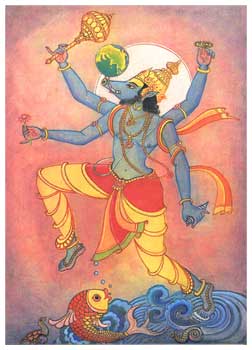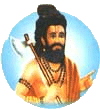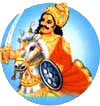 |

|
|
HINDU - TEN AVATARS OF VISHNU
The Hindu scriptures speak of the 10 Avatars of
Vishnu; different incarnations that take the form of divine
intervention provided by Vishnu during the various stages of human
evolution. When the forces of evil in the world become too strong,
Vishnu descends on earth and assumes different forms to restore
balance to the world.
He rests on the ocean on his bed of
Adisesha (serpent with 1,000 heads). Any time Lord Vishnu
sees great trouble, He takes an avataram to rescue the
people from evils. He is all merciful, ever rushing to serve
his devotees.
In the form of Mahavishnu he has four arms wielding the
chakra, conch, lotus & the gadha or mace in his four arms.
Some of the main avatarams of Vishnu are enumerated as the
Dasavataram (10 Incarnations).
The “dasavatara” (ten avatars) is meant to re-establish
dharma or righteousness and destroy tyranny and injustice on earth.
The last Avatar is yet to appear, and in many versions of the
mythology, the ninth incarnation is mentioned as Lord Buddha.
An avatar is an incarnation and means that a god
adopts a human form to be born on earth. Avatars were like
messengers, aspects of the gods who descended to Earth.
The number of Vishnu's avatars is sometimes
extended or their identities changed, according to local
preferences. Thus, Krishna is in some areas elevated to the
rank of a deity, and his half brother, Balarama, included as
an avatar. |

WORLD RELIGIONS
COMPARED
WORLD
RELIGIONS CLIPART
WORLD
RELIGIONS HOME
HINDUISM HOME
HINDU GODS |
Vishnu is regarded as the preserver of the universe and it is
therefore Vishnu’s incarnations that one encounters most often.
Vishnu has already had nine such incarnations and the tenth and
final incarnation is due in the future. These ten incarnations of
Vishnu are as follows:
 |
MATSYA: The fish. As
a giant fish, Vishnu warned the world of a great flood,
rescuing both a famous sage and the Vedas from the
flood.
|
 |
KURMA (KOORMA): The
tortoise. After the flood, Vishnu, in the form of a huge
tortoise, retrieved the gods' elixir of immortality,
which was lost in the depths of the ocean.
|
 |
VARAHA (VARAH): The
boar. After the demon Hiranyakasipu plunged the earth
into the ocean, Vishnu, in the form of boar, hoisted the
world above water on his tusks.
|
 |
NARASIMHA: The
human lion. In order to destroy another demon, Vishnu
became half-man, half-lion. This was because the demon,
Hiranyakasipu, could be killed by neither animal nor man
alone.
|
 |
VAMANA: The dwarf.
When Vishnu first came as a human avatar, he did so to
outwit the ruling demon-king, Bali. As a dwarf, he
convinced Bali to give him as much land as he could
cover in three steps. Immediately, Vishnu transformed
himself into a giant, striding across the universe.
|
 |
PARASURAM: The
angry man, Rama with an axe. Vishnu returned as Rama
with an axe to defeat the ruling warrior class and
restore the Brahmins to power.
|
 |
RAMA: The model of
reason, right action and commendable virtues. He is
often depicted with a tall conical cap which symbolizes
his royal status.
Rama represents an ideal man, as conceived by the Hindu
mind. In the story of Ramayana, Rama's personality
depicts him as the perfect son, devoted brother, true
husband, trusted friend, ideal king, and a noble
adversary.
|
 |
KRISHNA: The
statesman. As a youth, the cowherd Krishna became renown
as a lover, the sound of his flute prompting gopis
(wives and daughters of the cowherds) to leave their
homes to dance ecstatically with him in the forests.
|
 |
BUDDHA: Buddha began
his meditation as a Hindu. He was awakened with a new
enlightenment only to denounce Hinduism and emerge as
the founder of a new religion, Buddhism. To understand
Buddhism fully, one should not separate it from
Hinduism; while at the same time view it separately from
Hinduism. Buddha's way of life was "the golden mean" and
a relief from the pagan stigmas and caste system
prevalent in Hinduism.
|
 |
KALKI: The mighty
warrior. Yet to come, some Hindus believe Kalki is the
next Avatar of Vishnu. He will appear, riding his white
horse and drawing a flaming sword, at the end of the
Kali Yuga, the dark age through which we are
passing. His task will be to exterminate the evil and
restore the Dharma. Thus will begin a new cycle.
|
Whenever Dharma, or the situation
of law and order,
is endangered on this world,
I shall incarnate onto this world to re-establish Dharma, law and
order,
and to protect the good people and to destroy the evil elements of
the society
Lord Vishnu

| |
 |
 |

